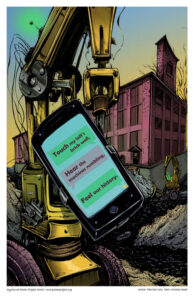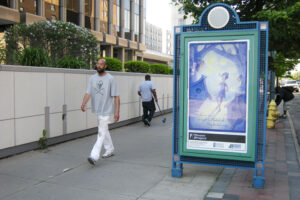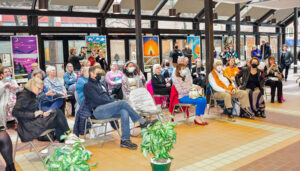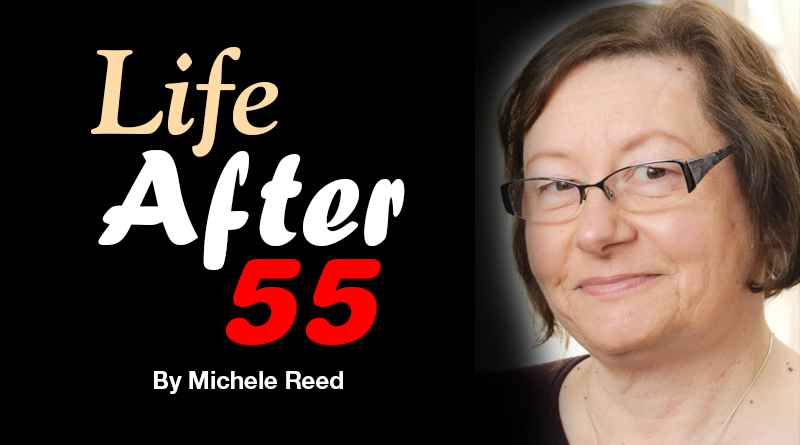Is Haiku for You?
By Michele Bazan Reed
Email: bazanreed@hotmail.com

One day last winter, I drove to a lookout spot where tourists and locals alike go to view Lake Ontario. It was nearly sunset, prime time for a stroll. But the cold winds and icy sidewalks meant I wasn’t going to chance a walk.
I rolled down the windows of my car and cranked up the seat heater, taking the time to gaze at the fierce beauty of the lake in mid-winter.
As I contemplated the scene before me, phrases sprung into my head in a familiar rhythm, and I grabbed my cell phone to type them in before I could forget them.
———
sunset lights the spray
as water crests the breakwall
framing the lighthouse
If you recognize the tell-tale syllable pattern — 5-7-5 — you probably guessed what I was doing: writing haiku.
Haiku, an ancient Japanese poetry form, is simple enough to learn. Some elementary school teachers even use it as an early lesson in creative writing. It also takes a lifetime to master. Many people in Japan and around the world have devoted decades of their lives to perfecting their haiku writing.
In English, haiku has three lines: five syllables in the first line, seven in the second and five in the third. Modern haiku poets tend toward shorter lines conveying their thoughts with a minimum number of words.
Haiku focus on a moment in time, and the poet’s reflection on it, and usually contain a seasonal element. The best have an element of wistfulness, their images noting the passage of time, or the fleeting nature of life.
I’ve been writing haiku for about 25 years and consider myself an amateur. Back then, the “Syracuse New Times” ran a contest called Syr-Haikus, featuring locally themed poems. I thought the name was funny, so I gave it a shot.
Soon I was hooked. I began writing haiku on my way to and from work each day, a 20-minute drive on country roads teeming with nature. The deer, herons, trees and flowers I encountered along the way were my subjects. I gained a new appreciation for the beauty of the nature I’d taken for granted. It helped clear my mind and relieve stress after a busy day. I’d arrive home refreshed, and jot the poems down in a little journal I kept for that purpose.

Since retiring, I’ve found haiku a great way to relax and connect with the world around me. After the death of my husband last year, I redoubled my efforts to practice haiku and that helped me get through some rough patches, as I wrote haiku about the loss, but also about happier moments we shared.
I’ve been fortunate over the years to take part in Syracuse’s Poster Project, an effort to bring together community poets and artists to bring art and poetry to our public spaces. An annual contest produces 16 large-format posters, each featuring a haiku about a unique feature of Syracuse or Central New York life, and illustrated by a local artist.
These are displayed in large outdoor panels on Salina and Warren streets, and in a rotating print collection that travels to different exhibit spaces during the year. Since 2001, 750 poets and 320 artists have produced 329 posters.
This year’s series launched April 21, and the posters can be seen in downtown Syracuse or online at www.posterproject.org.
The 2022 posters feature the “spirits of Syracuse” and mine honored the spirit of historic architecture, inspired by my loft apartment in a former spinning factory and warehouse.
Haiku has been such a part of my life I wanted to share it with you and encourage you to give it a try. I had the feeling that seniors may be especially suited to such a creative outlet. So, I reached out to folks in the Poster Project for advice.
About half of this year’s participants are 55 and older, confirmed Alyssa Dearborn, Vista volunteer with the Poster Project and a former artist.
“I’d say that seniors do bring something special to poetry because writing is one of those art forms that gets better with age,” she said. “Seniors produce very special poems for the Poster Project because of this. Seniors bring a unique perspective that is reflective of their life experiences. They are also our most consistent contributors.”
She sees many benefits to writing. “As a writer myself, I believe that there are so many benefits to writing,” she said. “Writing poetry and haiku in particular is a very healthy way to process feelings, experiences, and the world around you. It is a great medium for self-expression, mindfulness, and contemplation.”
“People can approach haiku as a simple word puzzle, matching the syllable count,” said Jim Emmons, cofounder and project coordinator. “Or, you can look into it, read about it, practice it as a form of poetry.”
This can lead to a daily practice, writing a haiku a day, he adds. “Some find it gets them through difficult times.”

Another benefit he sees is the collaboration between artist and poet. While not a close collaboration, it can open the possibility for lasting artistic relationship.
Alyssa suggested reading poetry or the Poster Project’s poetry blog to learn more about poetry, adding, “But if you’re interested in trying to write some poems, don’t be afraid to start. … Do not be afraid of a blank page.”
If you don’t want to contribute poetry or art, you can participate in the Poster Project by volunteering. They need volunteers and board members, especially if you have accounting, fundraising, or marketing skills. The website lists volunteer opportunities. And if you have no time to offer, they welcome donations to carry on the work of bringing art and poetry to our public spaces.
Why not give it a try? Who knows, you may find haiku is for you.
Photo: Poets, artists and the public gathered for the unveiling of the 2022 Poster Project posters, April 21 in the Atrium at City Hall Commons in downtown Syracuse.

